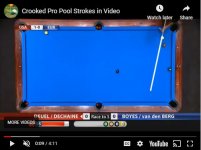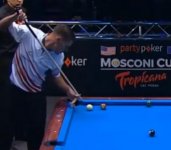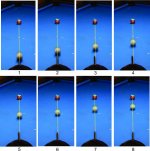Check out the following new video:
It is a follow-up to the following two recent videos that generated many comments on AZB, YouTube, and Facebook concerning the apparent crookedness of Samm's stroke during one of the shots:
NV J.33 – Top 10 Secrets of a Good Draw/Backspin/Screw-Back Shot
NV J.34 – Is this Stroke Crooked … or is it Parallax?
Check out the new video. I think it finally provides totally clear and convincing evidence to explain and demonstrate the optical illusions that can occur with video camera perspective and parallax effects related to an elevated cue or a cue that changes elevation during a shot (e.g., as with a pendulum stroke).
Enjoy,
Dave
It is a follow-up to the following two recent videos that generated many comments on AZB, YouTube, and Facebook concerning the apparent crookedness of Samm's stroke during one of the shots:
NV J.33 – Top 10 Secrets of a Good Draw/Backspin/Screw-Back Shot
NV J.34 – Is this Stroke Crooked … or is it Parallax?
Check out the new video. I think it finally provides totally clear and convincing evidence to explain and demonstrate the optical illusions that can occur with video camera perspective and parallax effects related to an elevated cue or a cue that changes elevation during a shot (e.g., as with a pendulum stroke).
Enjoy,
Dave



